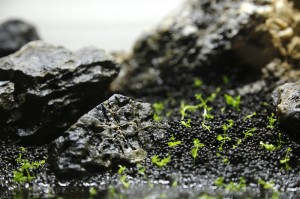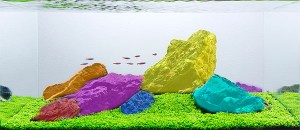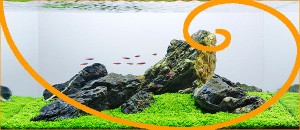George Farmer is well known in the aquascaping world. He is the co-founder of the UK Aquatic Plants Society and an incredibly talented aquascaper. I wrote about George in the past and referred to him as one of aquascaping’s most influential people. I still feel that way. So, when I came across a post by George on how he took a single pot (hence, the title of his work) of Tropica’s 1-2-Grow series Micranthemum sp. “Monte Carlo” and challenged himself to use it to create an entire aquascape, I was quite intrigued!
 The idea was simple. Take one pot of Micranthemum and plant it in a basic iwagumi style aquascape and see if it will grow enough to create a complete aquascape. It reminds me of the experiment done by Amano and pictured in his first book, Nature Aquarium World, only that, I believe, Amano used Glossostigma in that scape.
The idea was simple. Take one pot of Micranthemum and plant it in a basic iwagumi style aquascape and see if it will grow enough to create a complete aquascape. It reminds me of the experiment done by Amano and pictured in his first book, Nature Aquarium World, only that, I believe, Amano used Glossostigma in that scape.
The issue with these challenges is that few have the Buddha-like patience necessary to wait for the single pot to grow out. Most of us, myself included, would cave and order a few more pots to get it to fill in quicker! Of course, a less dense planting is also more susceptible to algae outbreaks so a skilled hand is necessary to maintain a good growing routine under these circumstances.
To deal with some of the issues, George used the “dry-start” technique that helps establish small-root plants before raising the tank’s water column. This is possible because no taller plants are being used that would otherwise require the water column to be higher. I typically use this method to start my foregrounds and, once it’s established, I raise the water and only then plant the middle and backgrounds.
As you can see below, maintaining a high humidity environment is critical for this to work. Additionally, starting with healthy plants that were grown hydroponically (emersed) increases the odds of this method working well without much die off.
As you can see from the image that started this post, George succeeded in his challenge giving testament to his unusual level of self-control. Outstanding! However, what caught my eye even more than the great growth he got out of the plant was the overall aquascape he created that, at least from the post, seemed to be glossed over.
Did George simply throw some rocks in to the aquarium haphazardly? Hmm… This could be a chance to see how good of an aquascaper George really is! Whenever you get a chance to look at the work done by an artist either quickly or without much thought, you get a chance to see how much that artist is doing subconsciously. How much have they internalized of the art they have worked so hard to master? This is what people mean when they say, “It comes so naturally to him.” (Usually followed by, “I hate him!“)
I’m digressing! Let’s take this opportunity we have at hand to analyze the work done by our friend, George, when we know he really didn’t spend a ton of time planning the aquascape. Let’s see how much George has internalized! We promise, George, we won’t hate you in the end!
Initial Impressions
At first blush, this seems to be a very good aquascape in the iwagumi style. I don’t have the luxury of going too deeply into the iwagumi style in this analysis, but I am planning an article that will go into iwagumi’s history and incorporation into aquascaping. For the time being, please look at the above link and my post on Reciprocity by James Findley for great iwagumi overviews.
George mentions that he used a simple 7 stone iwagumi. Although there isn’t a rule regarding the number of stones, time has shown that odd numbers work best for the overall aquascape. In my opinion, the more stones, the more complex (and more difficult) the layout.
Let’s highlight the seven stones George chose to use. Did you see them in the original picture above? Count the colors below.
In an iwagumi, each stone has a purpose in the overall aquascape. It’s true synergy in that one stone without the others would be “less”. However, while the group working in harmony is what makes a good iwagumi, each stone playing its role is also critical to make the aquascape harmonious.
The primary or anchor rock is called Oyaishi and it is your primary focal point. It should be the most majestic or striking rock. The second (or balancing) rock is called Fukuishi and it goes on either side of the Oyaishi rock. The third rock, called Soeishi, supports Oyaishi and sits alongside the Fukuishi. Finally, Suteishi rocks balance out the overall layout and give it complexity. Let’s see how George placed the rocks and why.
The Oyaishi is definitely the largest, most striking rock in the layout. It’s balanced by Fukuishi that is what you would expect and want. Soeshi is properly supporting Oyaishi and balancing the layout on the right (the traditional Sanzon iwagumi). Suteishi rocks are placed in locations that continue to support and balance the over all layout. Certainly the complexity of the layout is increased with the Suteishi George placed.
George’s placement of the Oyaishi is almost spot on. It is said that you want it to be about 2/3rds from the top of the aquascape to give it a focal point. We’ll confirm is George placed it at the true focal point of the aquascape later, but for now, see how he did hit the 2/3rd mark in the Rule of Thirds.
Let’s deconstruct George’s rock placement and see why he placed the Suteishi the way he did. Below you can see the back right rock removed. Do you see how the layout is out of balance? The layout is too heavy to the left. It’s subtle, but a critical element, in my opinion.
What is we remove the rock in the middle of the layout? What do you think it does to the overall impression?
Something is missing, right? It’s OK, but less complex than with the Suteishi stone there. George could have left it out but the overall layout is better with it in there. Remember, add until adding something detracts from the overall aquascape. There is a fine line with this type of element and it requires a very experienced understanding of aquascape layout. Impressive, George!
How about removing the back left rock? What does that do? Let’s see.
Wow! That really throws off balance, doesn’t it? I get the feeling the aquarium’s going to tip over with so much weight on the right side. Definitely better having that left rock to balance out the layout.
My only issue with the left rock is that bright white strip going down its side. My eyes immediately drift to it. I understand it’s natural veining in the rock and that the other rocks also have albeit to a lesser extent. Nevertheless, I think it would be better without it. See below what it would look like without the vein. What do you think?
Before moving away from the iwagumi style, I want to point out the direction of the rocks. The style tells us that the Oyaishi should be angled in a direction rather than be straight up and down. This gives a much more dynamic and natural impression of a current or movement. George does this well.
The supporting rocks should be angled to the Oyaishi in support of it but not conflict with the flow or movement created by the Oyaishi. Again, George does this exceptionally well. See the image below where I’ve highlighted the direction of movement. And, as a show of how masterful he is, George even photographed the school of Cardinals swimming in the exact direction of movement (current) that the Oyaishi depicts. Genius and pro tip to you beginners!
Rule of Thirds
As I’ve explained in the past, there are tried and true rules that have developed over centuries dealing with optimal layouts. These rules use mathematical equations that to humans represent the ideal. We’ve come to know these rules as the golden rules of layout and they can be seen in all great works of art, from paintings to photographs to aquascapes. I use these rules to see how close an aquascape comes to ideal layout.
One of the more famous of these rules is the rule of thirds. Essentially, this rule says that a layout is better (more dynamic) if your focal point is placed in one of the lines or intersection of lines found at the layout’s mathematical thirds. It’s hard to explain but easy to see. Here is the rule superimposed on George’s aquascape.
Bingo! This was the first rule I ran on the aquascape and it reinforced my initial impressions that this layout had something special. As you can see, George has hit the rule of thirds out of the park!
I’ve circled in red the area where there’s a critical intersection. Each represents a focal point with the top right one being the primary. It’s uncanny how George did this. Take a look at how the Oyaishi is sitting right on the third line.
The weight of the aquascape is sitting right on the third line almost perfectly. How did you do this George?? I couldn’t have done it any better even if I had measured it exactly. Also, in the next image, notice how the bottom weight of the aquascape sits right on the lower third line.
George has not only laid out the hardscape in a fantastic and complex 7 stone iwagumi style, but he’s managed to do it following the rule of thirds also perfectly! This was so striking to me that I actually reached out to George to confirm that he didn’t measure the layout as he installed it. He confirmed he only “eyeballed” it. I’m jealous…
Golden Triangles
The rule of thirds is only one of the rules of layout design that really impacts the overall composition. The proper use of triangles is just as important. You see, our brains are trained to see triangles for some reason. It’s a pattern that is hard-wired into us. We feel triangles are natural, comforting and give an overall impression of order. Let’s see if George did as well as he did with thirds?
Once again, George seems to be right on the line with the golden triangles. Notice the diagonal line going from bottom left to top right. It intersects the Fukuishi and Oyaishi stones perfectly. The weight of the stones is mostly in the lower right isosceles triangle with the opposite triangle being white space. This yin-and-yang with white space is very important and I rarely see it with beginner and intermediate aquascapes. Only the more advanced artists now the importance of white space and what it can do to the composition.
The two images below depict how simple triangles can also be brought into an aquascape to add complexity and pleasing symmetry. These triangles are subtle and you may not notice them at first glance. However, your brain picks them up and it feels that something is right or correct about this aquascape. It feels natural for some reason. One of those reasons is the use of triangles!
Golden Spiral and Focal Point
So George seems to be a master of hitting the thirds and the triangles. It is obvious that his many years of working with aquascapes and noticing what works and what doesn’t have paid off. He is naturally placing key elements of the composition in just the right places as dictated by the golden rules. He does this with his gut. “It comes naturally to him.” No, we don’t hate him, though, because his gut is the result of years of practice and observation.
Let’s see how well the One-Pot Iwagumi does in terms of the golden spiral and it’s indication of the primary focal point.
The golden spiral is a beautiful and mystical mathematical formula that is used to indicate the primary focal point of a work of art. The thought is that the piece’s primary focal point should be where the spiral ends.
As you can see, George placed the top of the Oyaishi stone at almost the exact position indicated by the spiral. This is where the eye will look. How uncanny that he did this without much thought!
I was so intrigued that I ran the most complicated formula that subdivides the spiral type into sub-areas to see just how close he got to the mathematical idea. See the result below. His positioning of the Oyaishi stone would not change even if he had run this formula prior to positioning it. Extremely well done!
Depth of Field and Perspective
Depth of field and perspective are just tricks used to give the impression that the aquascape is much larger than it seems. It accentuates the 3D space occupied and expands it.
This aquascape achieves perspective and depth of field by using smaller stones and placing them closer to the front pane while larger ones are to the back. This gives an impression of depth. The aquascape certainly looks larger than what it really is. This is difficult to do when you only use rocks and one type of plant.
It is more common to see larger items upfront with smaller items transitioning to the back in some aquascape styles. This gives the impression of items in the back being very far away.
My sense of perspective here is looking from a distance at weathered and worn mountain peaks that are surrounded by a sea of grass or low trees. I get the feeling of openness. A wind-swept mountain.
What do you feel when taking it all in? Describe you feeling? Can you almost smell something? These are the things that are, at the end of the day, most important in judging an aquascape.
Color Choices
Color is so important to an aquascape but not many people focus on it. To me, proper use of color completes an aquascape. Improper use can severely detract from it. Make it less than it what it could have been.
One of my upcoming posts will be on the use of color theory in aquascapes. For now, however, let’s just focus on some basics. Colors can impact us mentally and physically. Being able to use colors consciously and harmoniously can help you create spectacular results.
Colors can be harmonious to one another. Some are complimentary, others analogous. One model is called triadic and it’s what George’s aquascape uses. Taking a quote from the above linked site on color theory:
A triadic color scheme uses colors that are evenly spaced around the color wheel. Triadic color schemes tend to be quite vibrant, even if you use pale or unsaturated versions of your hues.To use a triadic harmony successfully, the colors should be carefully balanced – let one color dominate and use the two others for accent.
The image above is what I got when I used George’s aquascape and ran it through the color wheel analyzer. The triadic color scheme is obvious. George uses green to dominate and the other colors accent it.
The blue/black slate color serves as an accent to the green. I then picked up on George’s choice to use Cardinals with their red and blue. Just the right colors in the color wheel to accentuate the green.
It’s interesting that George first put red eye Tetras but felt they were wrong because they got lost into the background. I totally agree. Picking the right fish to complement the composition is harder than most people think. Unfortunately, the fish are usually an afterthought and the aquascape suffers for it.
In this case, George recognized something was wrong and chose Cardinals instead. Again, I totally agree…and so does the color wheel.
 Notice also how the small size of the Cardinals and their swimming habit complement the overall composition. Any bigger and the fish would detract from the aquascape and throw off the entire perceptive. George does an excellent job here in terms of the color, size and swimming habits.
Notice also how the small size of the Cardinals and their swimming habit complement the overall composition. Any bigger and the fish would detract from the aquascape and throw off the entire perceptive. George does an excellent job here in terms of the color, size and swimming habits.
Final Impressions
If you read all the way down here, you know we’ve looked at George Farmer’s One-Pot Iwagumi from many different perspectives. We’ve deconstructed it and discussed it’s individual parts. These parts were put together, apparently without too much thought, by one of the true masters of aquascaping. It is obvious that he has, in fact, internalized many things that most people would need to carefully plan. I stand in awe.
I think George’s intention with this challenge was to show people that you can create a complete aquascape with only one tiny pot of plants. In so doing, he has also revealed much deeper teachings some of which we discussed in this humble analysis. I’m sure as I continue to think about this composition, I will see many more things that I have so far overlooked. This is especially true as I’ve not had the privilege of studying the details that it contains.
It is well known that it takes many years of practice to make something look effortless and natural. With this aquascape, George has done just that. He has executed an iwagumi with masterful skill. At first blush, it looks natural and simple, almost minimalistic. It is only when you start to deconstruct it to its bones that it’s brilliance shows itself.
Well done, George. Very well done.
All the best,
Art
Here’s a great HD video of the aquascape in progress:
Important Note: The unmodified images used in this article except for color_wheel are the copyrighted work of George Farmer and used with permission. Modified images are copyrighted by ScapeFu.com All Rights Reserved.



























3 Comments on “Aquascape Analysis of George Farmer’s One-Pot Iwagumi”
Pingback: Djurmagazinet | Aquacapeanalys
Pingback: Oliver Knott & Aqvainnova Plants - ScapeFu025 - ScapeFu
Pingback: Bookshelf of Aquariums - Page 10 - The Planted Tank Forum